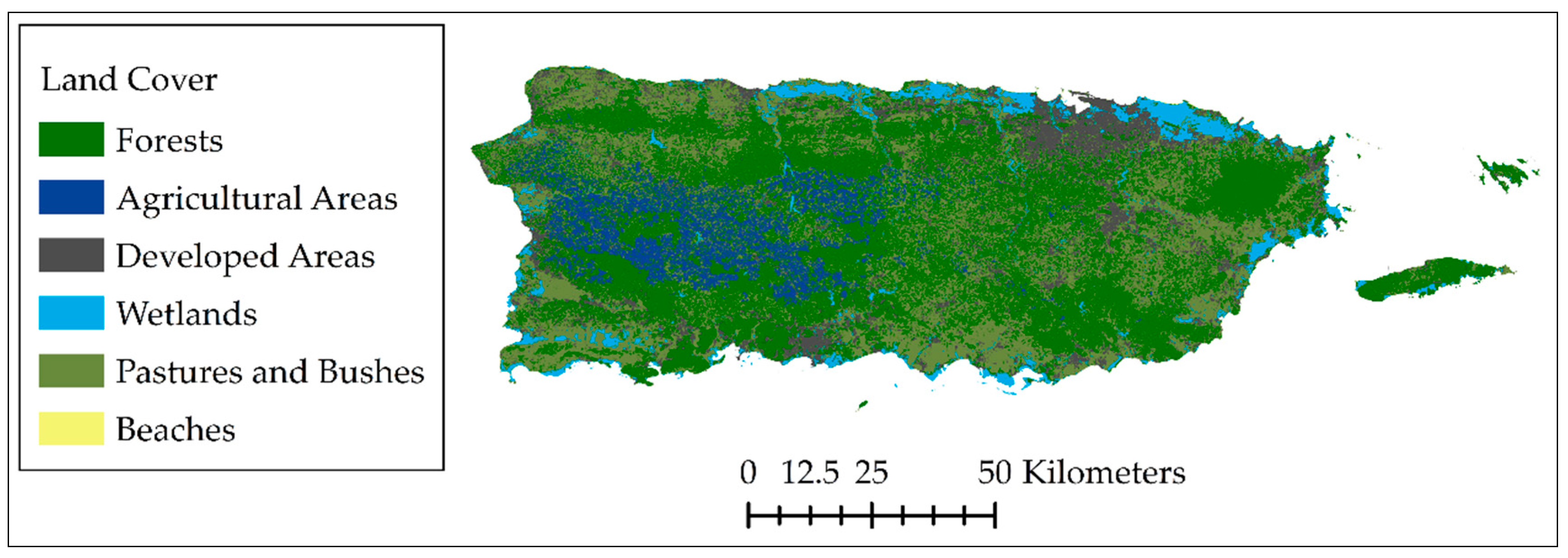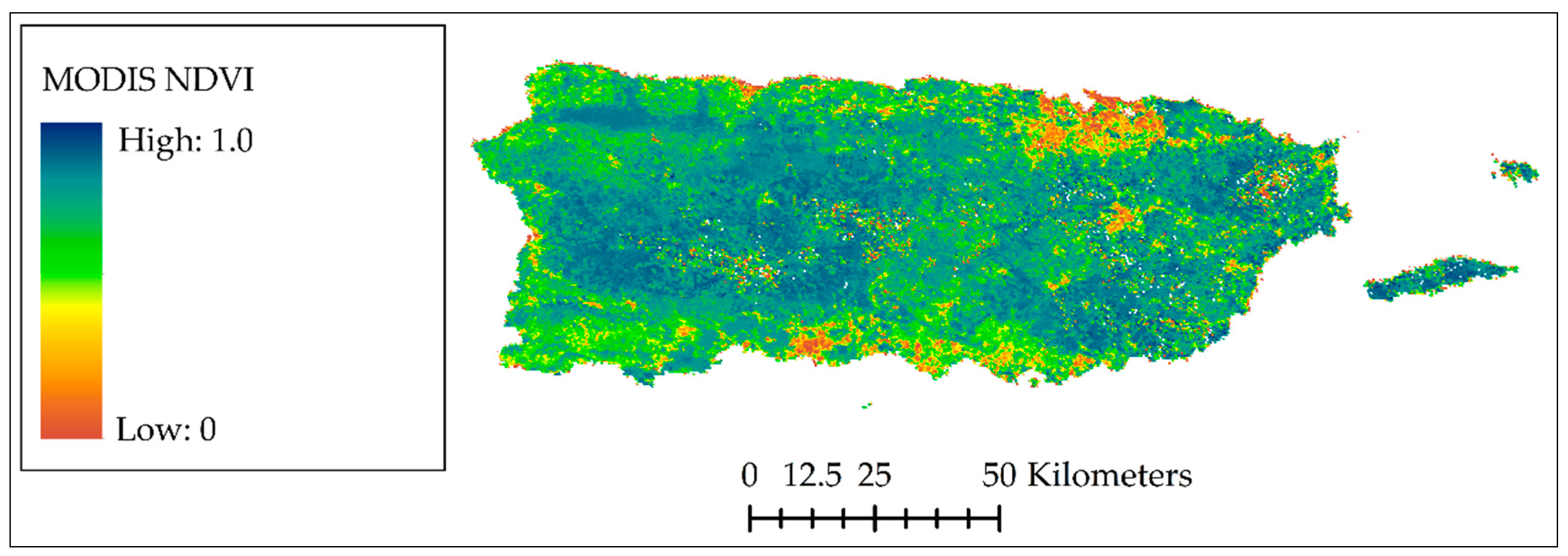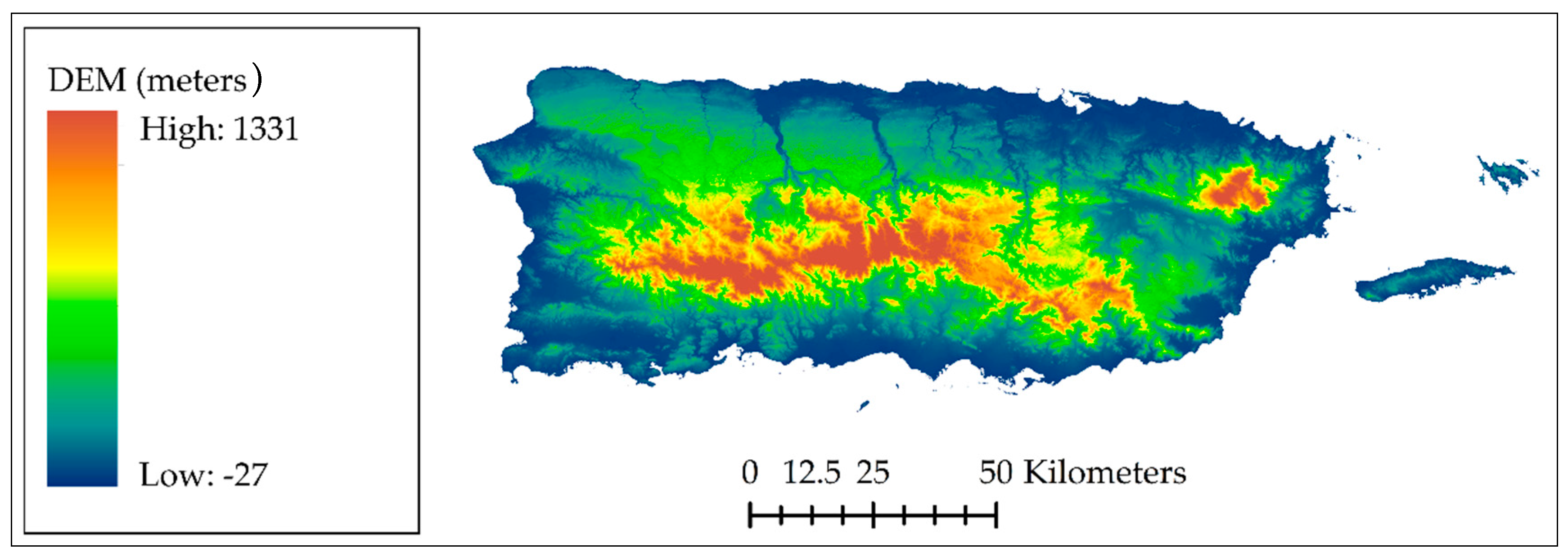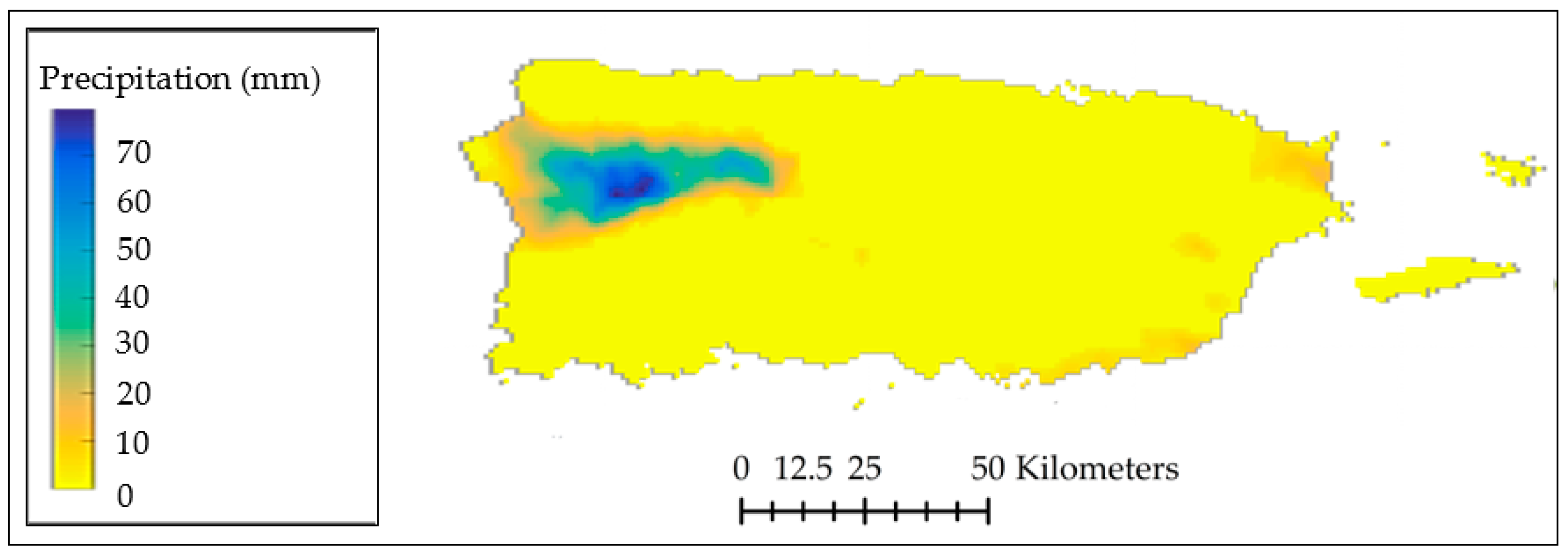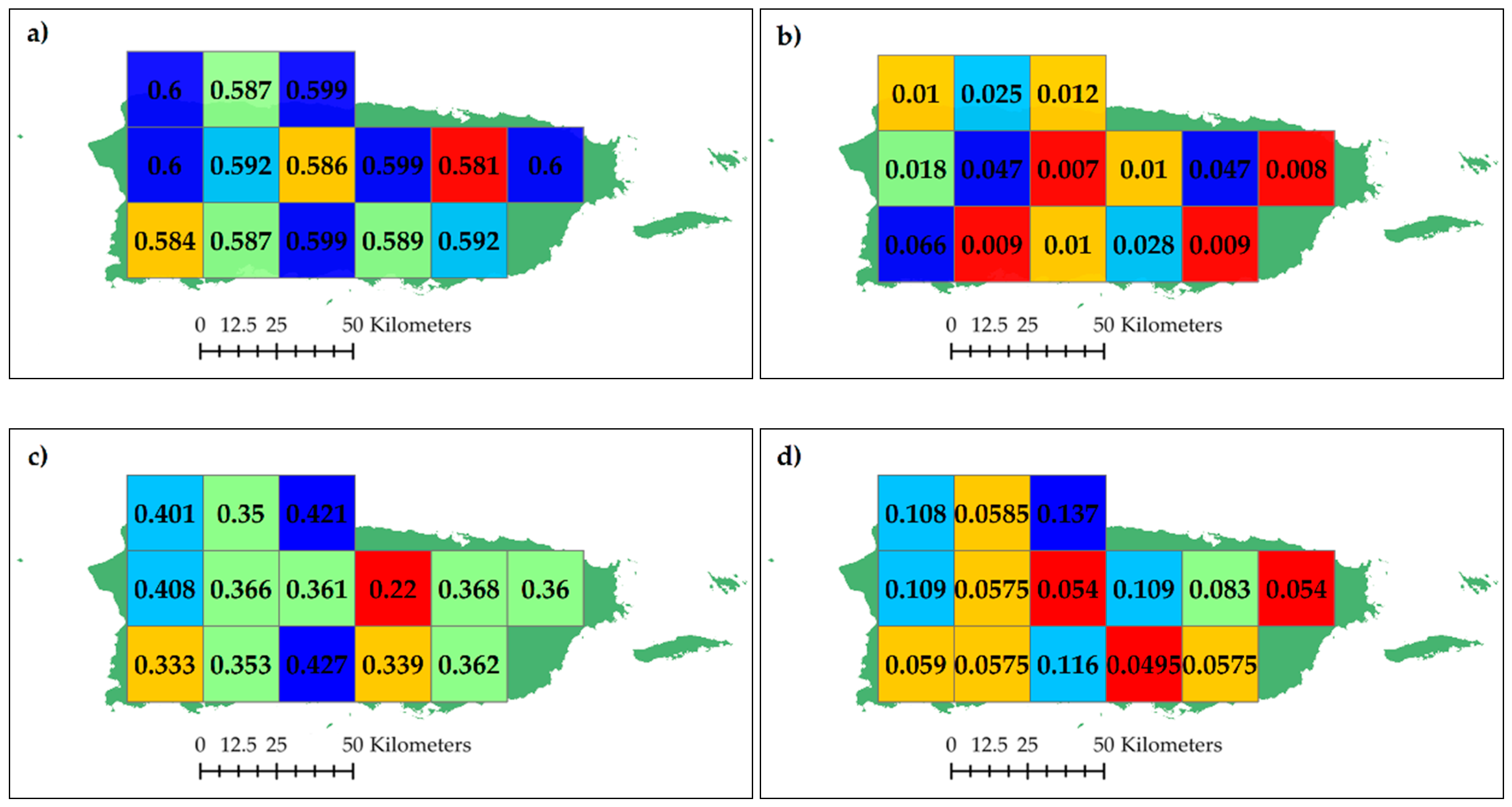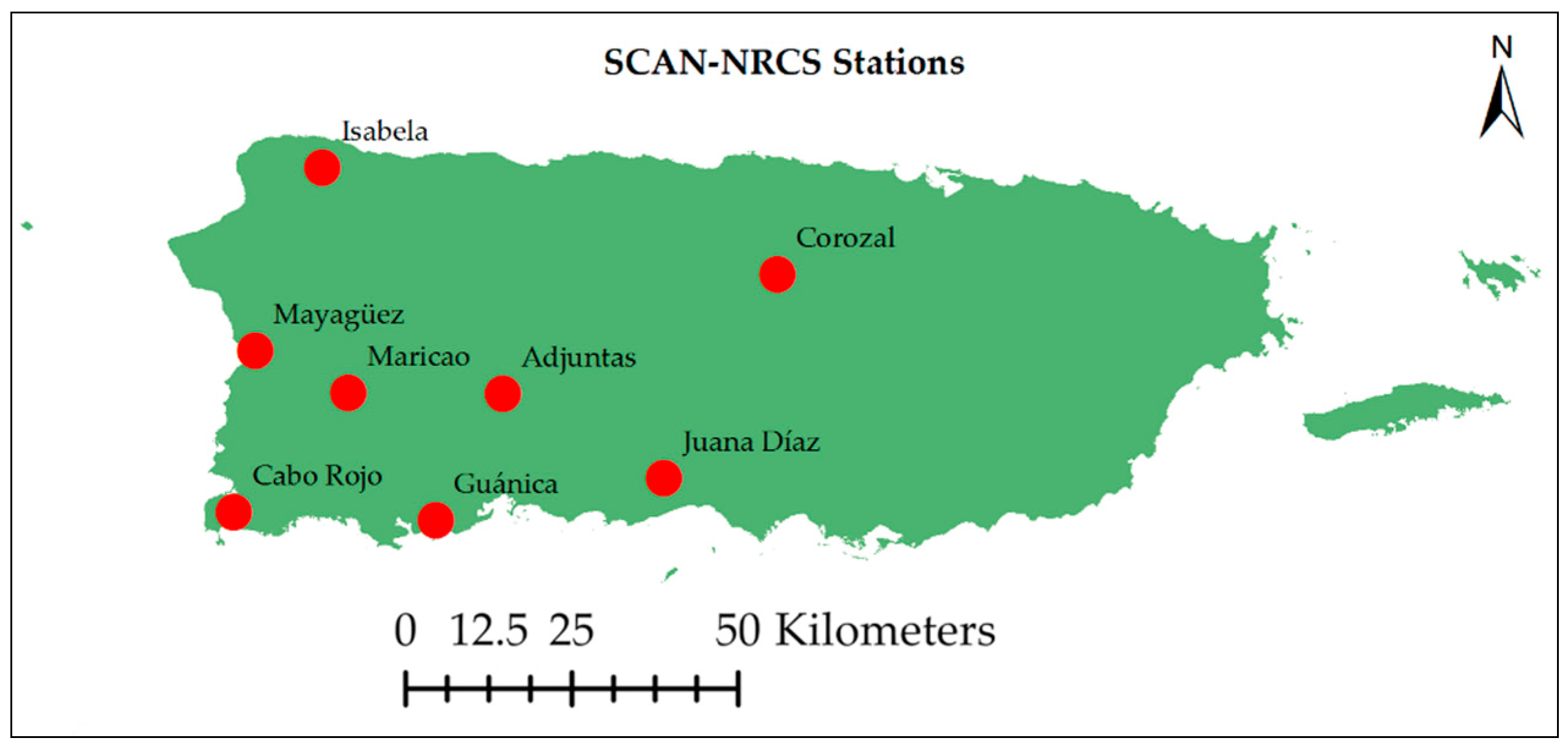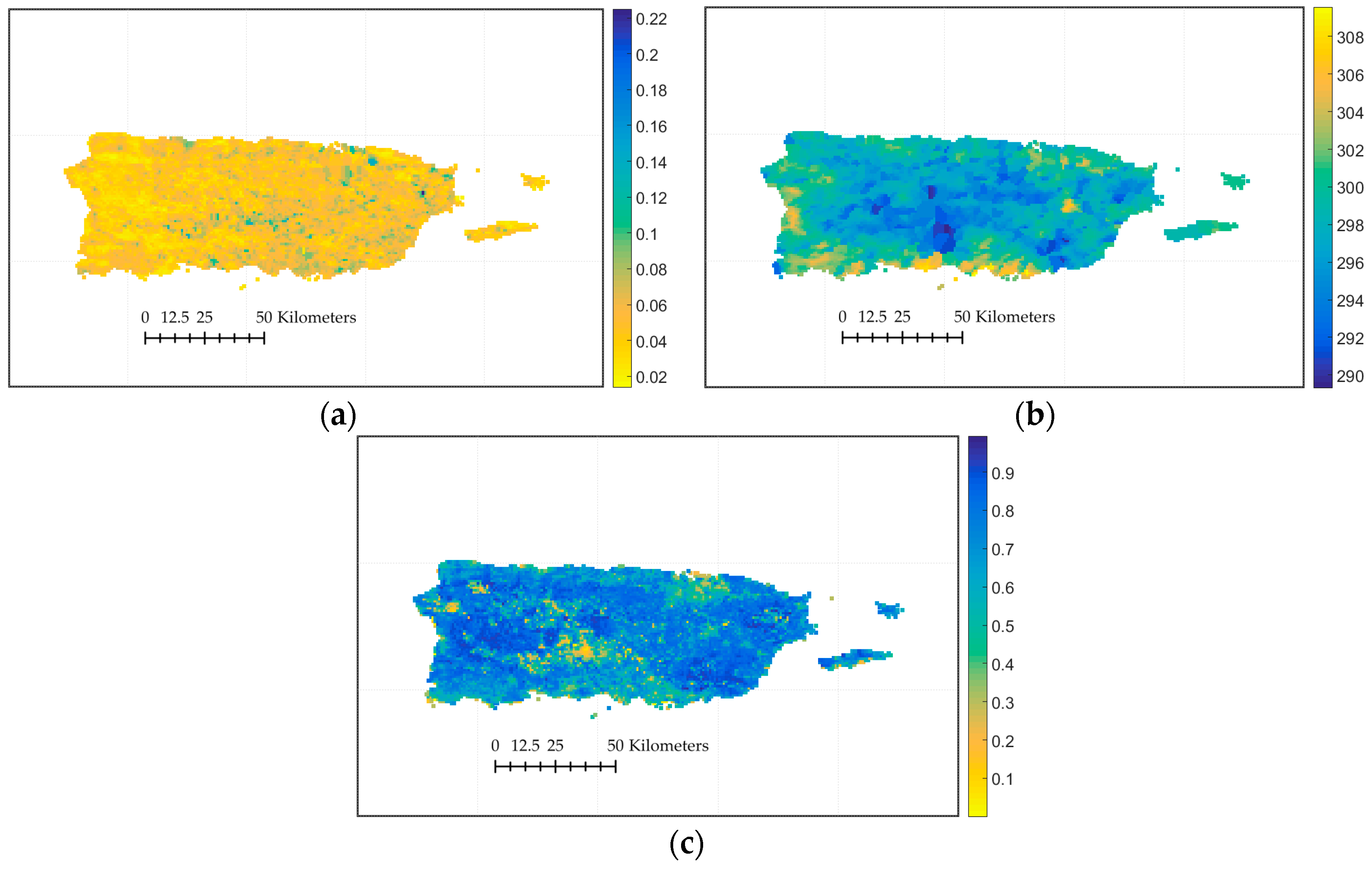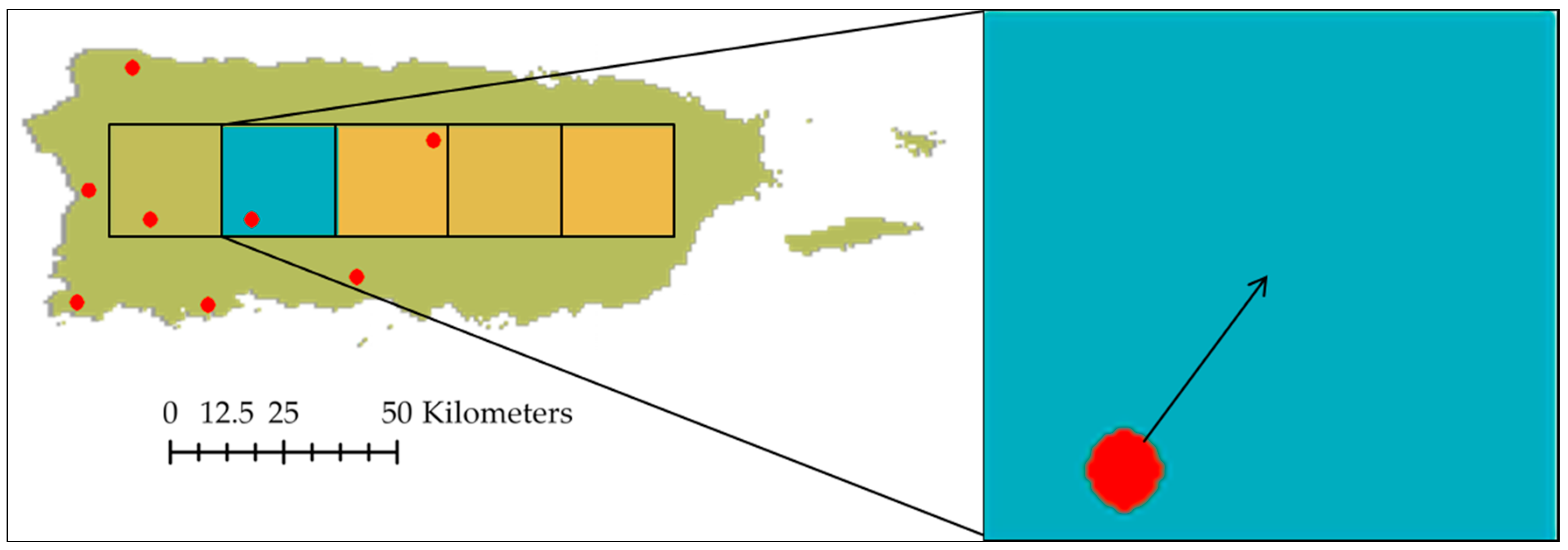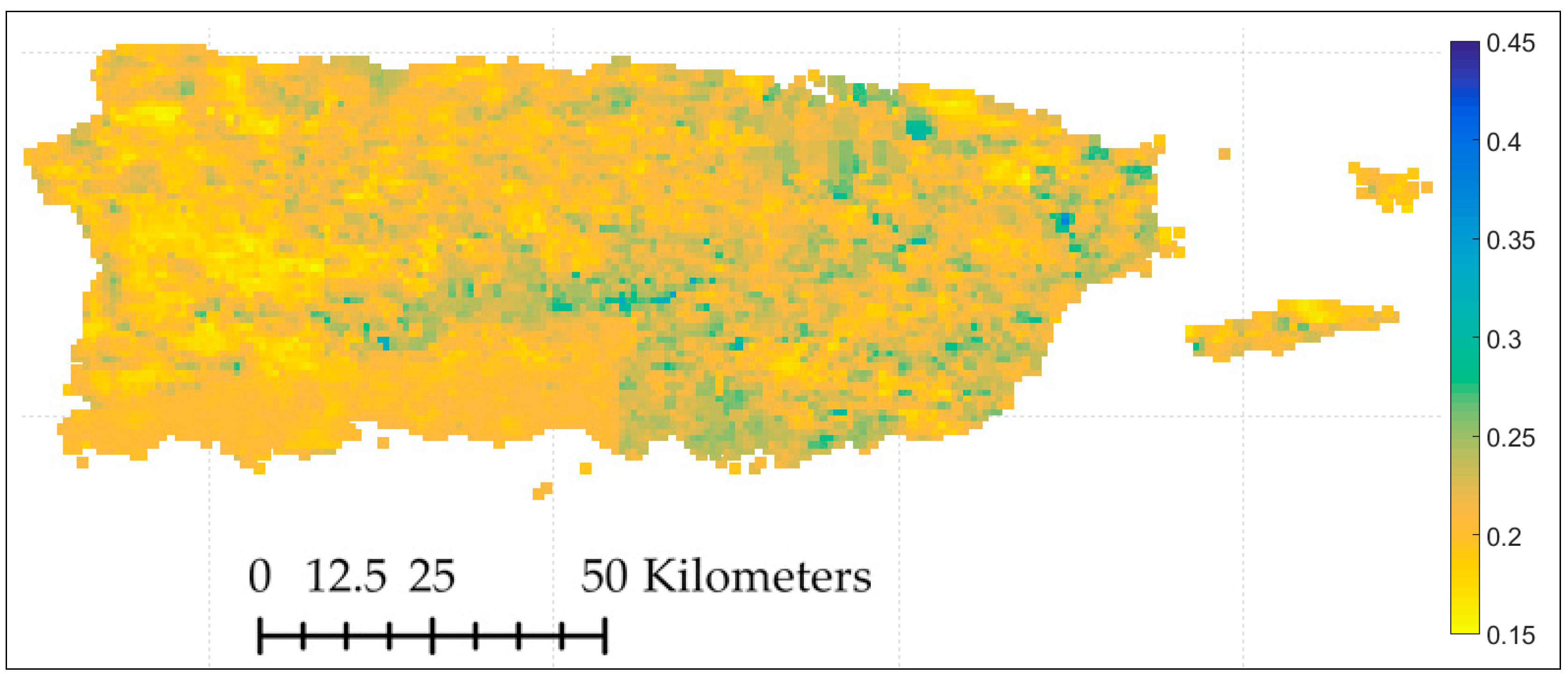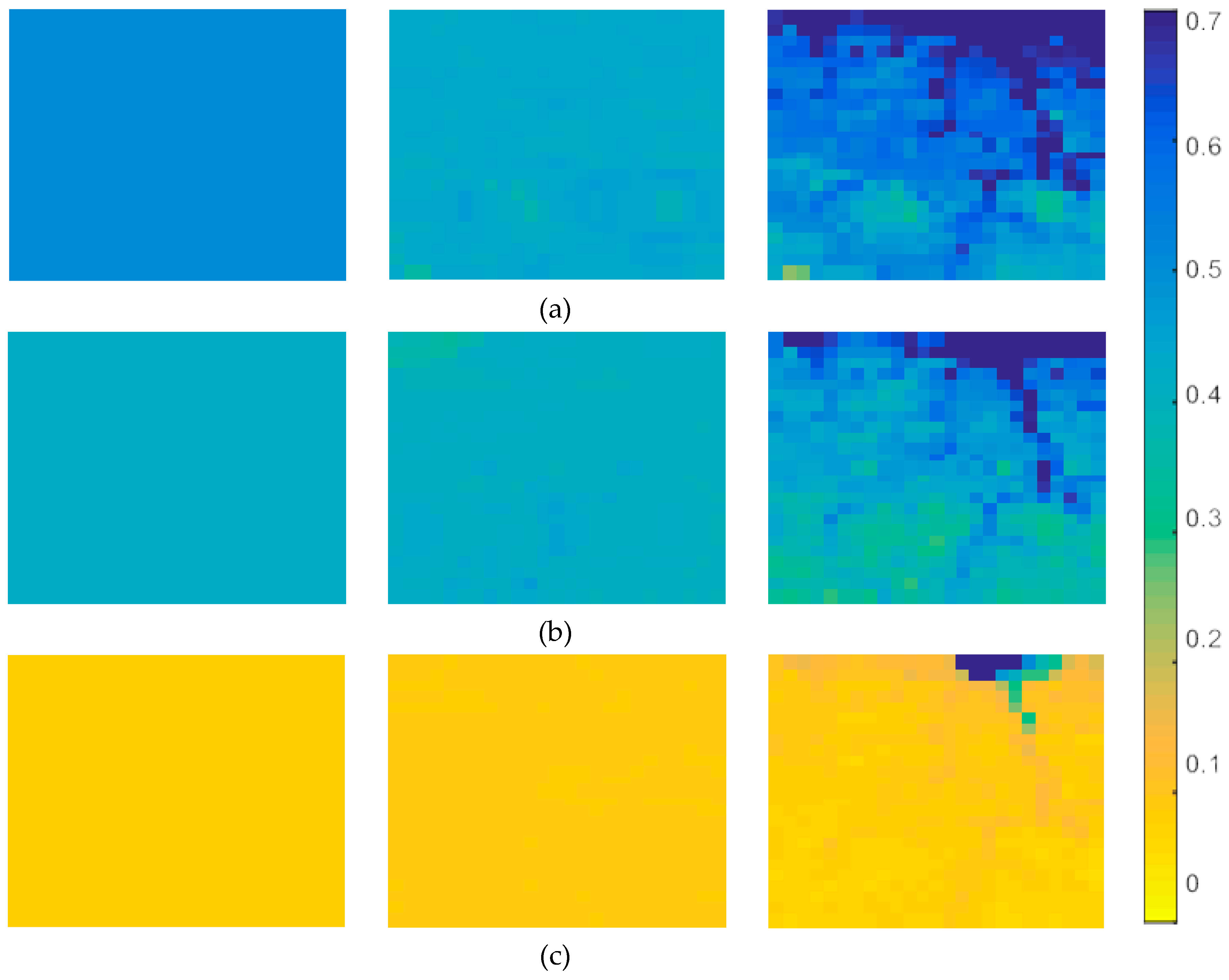1. Introduction
Soil moisture (SM) content is the quantity of water accumulated in soil pores, usually recorded as percent or volumetric ratio (e.g., cm
3/cm
3) for different depths (e.g., 5 cm, 10 cm, and 25 cm). SM plays an important role in water cycles, hydrologic studies, agricultural activities, and environmental monitoring [
1,
2,
3,
4,
5,
6]. Hydrologic modeling systems are very sensitive to changes in SM values for applications involving flood control and drought assessment [
1]. In agricultural activities, best management practices and irrigation control can be optimized with continuous spatio-temporal SM measurements [
7]. Predictions and results for environmental monitoring applications such as climate change and weather forecasting have a high dependency on the accuracy of the SM data [
5,
6,
8]. The spatio-temporal availability of accurate SM measurements rely on the quality of the instruments, frequency of retrieval, and management of the data [
2]. There are three options for acquiring SM content: ground-based measurements, modeling predictions, and remotely-sensed estimates [
1,
3].
The SM measurements collected in the field, which are usually referred to as in situ measurements, are commonly retrieved in high or low density networks of point measurements. The density of a network is determined by the quantity and assembling of instruments, the area of study, and the budget of the project. There are various instruments and techniques used to obtain ground-based measurements. Time domain reflectometry (TDR) instruments measure the soil dielectric permittivity, which is commonly used to quantify SM, since its value increases with the higher presence of water [
3,
9]. The TDR instruments provide accurate SM measurements for a specific location that can be represented as a point measure in a map. Another type of instrument used to collect in situ SM measurements is based on cosmic-ray detection. The COsmic-ray Soil Moisture Observing System (COSMOS) measures the quantity of fast neutrons above the land surface, which have an inversely correlated relationship with SM due to kinetic energy loss, and provides an estimate of SM over a horizontal footprint with a diameter of about 600 m [
9]. This kinetic loss happens when fast neutrons collide with hydrogen atoms found in wet land surfaces [
9]. While in situ measuring provides accurate products, the instruments can be difficult to calibrate and maintain without high technical knowledge, and the availability of an adequate network that meets the requirements for each individual project is very limited [
1].
Soil moisture can be simulated at different spatio-temporal resolutions using modeling systems [
3]. The quality of the simulation is tied to the accuracy of the in situ data used as the training dataset, and the right implementation of a validation and optimization process [
3,
10]. There are a variety of modeling systems used to simulated soil moisture, such as the SM Accounting, the SM Water Balance Model, and the variable infiltration capacity (VIC) model [
3,
11,
12,
13]. As an example of how these models work, the VIC model simulates SM based in correlations between land cover, SM storage capacity, topography, and precipitation [
12,
14]. A simulation can be performed for various spatio-temporal resolutions, depending on the objective of the project [
3]. However, the poor availability of ground-based SM data networks, the uncertainty of forcing data, and the model structure will affect directly the process of simulation, validation, and optimization of the modeled SM products [
13,
15].
Satellite-based microwave observations can retrieve SM estimates at different spatio-temporal resolutions [
1,
3]. Passive microwave depends on the physical temperature and surface emissivity of the earth’s surface. In principle, passive sensors, such as radiometers, measure the thermal emission of the surface at the microwave wavelength, and translate that energy to brightness temperature [
15,
16]. The response of the soil to an electromagnetic wave depends on its texture, surface roughness, organic matter content, iron oxide content, and moisture content [
17]. In general, radiative transfer models such as the tau-omega (τ-ω), use the dielectric constant alongside other characteristics of the soil, such as an incident angle and brightness temperature, to estimate SM with remote sensing technologies [
17,
18,
19,
20]. Satellite-based SM products are provided at a global scale by satellite sensors such as the Soil Moisture Active Passive (SMAP) Mission from NASA (
https://smap.jpl.nasa.gov/), the Soil Moisture and Ocean Salinity (SMOS) from the European Space Agency (
http://www.esa.int/Our_Activities/Observing_the_Earth/SMOS), the Advanced Microwave Scanning Radiometer for the Earth Observing System (AMSR-E) (
https://nsidc.org/data/amsre) from the Japan Aerospace Exploration Agency (JAXA), and the AMSR-2 also from JAXA (
http://suzaku.eorc.jaxa.jp/GCOM_W/). An advantage of the current satellite-based remotely-sensed SM products is the availability of global scale measurements at a continuous spatio-temporal resolution [
1,
7]. However, at the current state, the satellite-based products are available at coarse spatial resolutions ranging from 3 km to 40 km, which are not useful for small scale hydrologic modeling and agricultural applications. Also, due to the availability of ground-based networks, the validation process for satellite-based products is very limited [
1,
7,
21]. Recent studies have been working on the improvement of the soil moisture estimations of satellite-based products using different algorithms that relate soil moisture with variables such as vegetation, brightness temperature, precipitation, and others [
21,
22,
23].
1.1. Soil Moisture in Puerto Rico
The spatio-temporal availability and accuracy of SM measurements are key elements to acquiring the best possible outcomes in applications involving hydrologic modeling, agricultural management, and weather monitoring. Unfortunately, in Puerto Rico the resources available to retrieve accurate SM measurements are very limited. Currently, the Soil Climate Analysis Network (SCAN) of the Natural Resources Conservation Service (NRCS) has eight stations around the center and western regions of the island retrieving in situ SM content. The data collection is available online (
www.wcc.nrcs.usda.gov), and provides over five years of hourly and daily SM data. Simulated SM is available from the Geostationary Operational Environmental Satellite—Puerto Rico Water and Energy Balance (GOES-PRWEB) model (
https://pragwater.com/goes-puerto-rico-water-and-energy-balance-goes-web-algorithm/) at 1 km resolution, which uses a water and energy balance approach to simulate different hydrologic parameters such as surface runoff, stream flow, and SM. However, the GOES-PRWEB SM product has not been officially validated. Remotely sensed SM data can be retrieved from the various missions such as SMAP, SMOS, or the Global Change Observation Mission—Water 1 (GCOM-W1) satellite system. This research is based on data from the Advanced Microwave Scanning Radiometer 2 (AMSR2), a sensor carried by the GCOM-W1 satellite system. The AMSR2, which launched in May 2012, is a microwave radiometer that estimates SM worldwide every two days at a 25 km resolution [
6,
23]. The SM product can be downloaded from the Earth Observation Research Center (EORC) of the Japan Aerospace Exploration Agency (JAXA) website (
https://gcom-w1.jaxa.jp), and is available on a daily or monthly basis at 10 km and 25 km resolutions.
1.2. Scope and Objectives
Since resources of accurate SM measurements are very limited in Puerto Rico, the scope of this research is to assess the quality of the AMSR2 data and perform a downscaling technique to provide a better description of how the sensor perceives the surface SM as it passes over the island. The comparison consists of the evaluation of the difference between the satellite-based and the ground-based measurements by means of the mean error (ME), the root mean squared error (RMSE), and the correlation coefficient (R). Two downscaling techniques are used, and their performances are studied. The first technique used to downscale the AMSR2 SM products to a finer downscaled product consists of a simple linear equation that relates the coarse resolution AMSR2 SM with three parameters retrieved from the Moderate Resolution Imaging Spectroradiometer (MODIS). These three MODIS parameters are the Normalized Difference of Vegetation Index (NDVI), the Land Surface Temperature (LST), and the albedo. The second technique is an algorithm that relates weighted values of sand fraction, elevation, and NDVI with the AMSR2 SM product. The performance of each method was analyzed with the hopes of providing a better method for the retrieval of SM in Puerto Rico.
4. Results and Discussion
4.1. Comparison of AMSR2 with SCAN–NRCS Soil Moisture Products
All of the available data from September 2012 to January 2017 of AMSR2 SM products at a resolution of 25 km for both ascending and descending overpasses were compared with each SCAN–NRCS station over Puerto Rico. For the analysis, the maximum, minimum, mean, and standard deviation were calculated for each station, and all of the AMSR2 pixels that were matched by distance, as previously explained. The ascending and descending statistics results are shown in
Table 1 and
Table 2, respectively.
The maximum values of both overpasses of the AMSR2 SM are very congruent to the NRCS stations located in mountainous areas (Adjuntas, Corozal, and Isabela), where high humidity and frequent precipitation events are common. The minimum values of both overpasses of the AMSR2 SM underestimated the SM with respect to the NRCS readings for all of the stations, except for Guánica. This exception takes effect because the NRCS station in Guánica is located in an area known as the “Bosque Seco”, which directly translates to “Dry Forest”, and is known to be one of the most arid regions with low humidity and a low frequency of precipitation events in Puerto Rico. The mean values and standard deviations for AMSR2 readings with respect to the NRCS stations during both overpasses are low and very similar, revealing a consistent tendency of all the AMSR2 readings over PR to underestimate SM.
The percent of instances where the error was inside the range of ±0.15 (%), ME, RMSR, R, and the mean distance from station to centroid (Distance) are shown in
Table 3 and
Table 4. Overall, AMSR2 SM products for both overpasses tended to underestimate for all of the SCAN–NRCS stations, except for the station in Guánica, which is one of the most arid regions of the island.
The percent of error inside the ±0.15 range (%) and the mean distance of the nearest available AMSR2 pixel centroid with respect to each NRCS station (distance) readings both are influencing the values of ME, RMSE, and R. Lower % values decreases ME and RMSE, while increasing R.
If the distance is over 12 km ME and RMSE increases, R decreases. High R values were found in areas where the mean values of the NRCS SM readings in humid areas were equal to or higher than 0.30, the % was equal to or less than 40%, and the distance was less than 12 km. This high correlation reveals that when the AMSR2 is not underestimating SM, it provides a moderately good estimate within the range of the pixel, if the mean SM in the area is equal or higher than 0.30. Low R values were found in arid areas, where the mean SM was lower than 0.30, the lower distance increased the R up to 0.630.
4.2. Downscale of AMSR2 with Albedo, LST, and NDVI
The AMSR2 25 km resolution SM product was downscaled to 1 km resolution with a simple linear equation involving MODIS products for Albedo, NDVI, and LST. The average resultant downscaling equation for all AMSR2 data is shown in the following equation.
where θ
s is the downscaled SM, A is the albedo, T is the land surface temperature, V is the normalized difference of vegetation index, and the rest are the interactions between A, T, and V (TA, VA, and VT). The regression model achieved a moderate correlation of 0.6102 and an overall RMSE of 0.0050, which indicated that the model was a good fit with the AMSR2 estimates. To reinforce this statement, R-squared was calculated, and the F-statistic test was performed. The R-squared was 0.037, and the
p-value of the F-statistic test was less than 10
−4. These results reinforce the statement that the model is providing a good fit.
Table 5 shows that all of the
p-values are below the significant level (5%), meaning that the null hypothesis is rejected for each coefficient, and all of the terms in the linear equation are significant.
Figure 5 shows a sample for the downscaled AMSR2 SM values over PR using MODIS parameters Albedo, LST, and NDVI.
The following table (
Table 6) presents the basic statistics for the comparison between the downscaled product using the MODIS parameters and the SCAN–NRCS SM measurements. In contrast with the comparison of the SCAN–NRCS measurements with the raw AMSR2 SM products, the downscaled product achieved a higher percentage of SM estimates that behave similar to the SCAN–NRCS data. In terms of R, the correlation slightly decreased. A potential solution to the decrease of correlation could be the optimization of the downscaling technique.
4.3. Downscale of AMSR2 with Sand Fraction, Elevation, and NDVI
This approach for the downscaling of AMSR2 was performed with an algorithm that used the weighted control parameters sand fraction, elevation, and the Normalized Difference of Vegetation Index.
Figure 6 shows a sample 25 km pixel of the AMSR2 SM (left), the downscaled SM using MODIS parameters (center), and the downscaled SM using physical parameters (right) during (a) high humidity (SM ≥ 0.60), (b) moderate humidity (60 > SM > 0.25), and (c) low humidity (SM ≤ 0.20).
When the sand fraction is low, the value of the void fraction is higher, which provides more space for water to infiltrate, and decreases the SM. With changes in elevations, the lowest values accumulate moisture, providing higher SM values. The NDVI provides an estimation of the vegetation density in an area. When the NDVI value is high, more precipitation is intercepted, and more moisture is absorbed by the vegetation, which decreases the SM in the area.
The previous table (
Table 7) presents the basic statistics for the comparison between the downscaled SM product using physical parameters and the SCAN–NRCS SM measurements. The outcome of the downscale in terms of correlation and percent of SM values that behaved similar to the SCAN–NRCS measurements was analogous to the results from the first downscaling. The most significant outcome from this downscale technique is the improvement of SM estimation of the Mayagüez SCAN–NRCS station. This improvement happens due to the consideration of the changes in topography, sand fraction, and NDVI in the algorithm, since this particular station is located at the bottom of a hill in an area where precipitation events are frequent.
5. Conclusions
The comparison of AMSR2 SM products at 25 km resolution with the SCAN–NRCS stations revealed that the AMSR2 spatial coverage of 25 km does not provide a good estimate of SM in Puerto Rico. The overall results of the validation show that about 49% of the AMSR2 SM estimates behave similar to the SCAN–NRCS SM measurements, with an overall correlation of 0.613. The low correlation between the coarse resolution estimate and the ground-based measurements is due to changes in land use, vegetation density, topography, soil properties, and precipitation in Puerto Rico (
Figure A1,
Figure A2,
Figure A3,
Figure A4 and
Figure A5). As well, in order to have a more robust validation, additional field data is needed inside the 25 km pixels.
The downscaling method using MODIS parameters provided a better fit with the AMSR2 data. The resulting SM from the linear equation that relates Albedo, LST, and NDVI from MODIS with the SM from AMSR2 showed a tendency to increase SM where a precipitation event occurred. This enhancement increased the percentage of AMSR2 estimates that behave similar to the ground-based measurements to 55%. To expand the coverage of the AMSR2, a daily average SM value was assumed for the area that was left out of the 25 km grids. This assumption led to the decrease in correlation, and can be modified in future research to assess this issue. The second approach, in which a weighted value of physical parameters was used, provided a better projection of how the SM is distributed throughout the pixel area, increasing the percentage of AMSR2 estimates that behave similar to the ground-based measurements to 56%. By considering sand fraction, elevation, and NDVI as variables to enhance SM estimations of the AMSR2, a significant change was observed where the R in the Mayagüez station increased from 0.647 to 0.955, and the percentage of AMSR2 estimates that behave similar to the ground-based measurements increased from 4% to 42%.
Future research is needed to improve the downscaled products for both methodologies, such as: exploring how the addition of other variables such as precipitation would affect the downscaled product, a comparison of how different vegetation indexes such as the simple ratio infrared index, or the soil-adjusted vegetation index influences the quality of the downscaled products. Other future research will include the optimization of the downscaling techniques through a sensitivity analysis, and the incorporation of a dense network of sensors placed inside the area of coverage of one AMSR2 pixel, in order to provide a better validation of the AMSR2 and the downscaled SM products in Puerto Rico.
